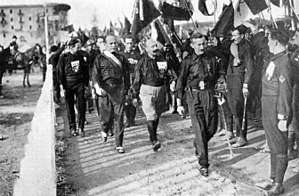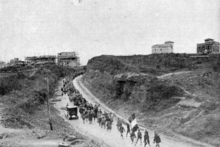March on Rome
The March on Rome (Italian: Marcia su Roma) was an organized mass demonstration in October 1922, which resulted in Benito Mussolini's National Fascist Party (Partito Nazionale Fascista, or PNF) ascending to power in the Kingdom of Italy (Regno d'Italia). In late October 1922, Fascist Party leaders planned an insurrection, to take place on 28 October. When fascist troops entered Rome, Prime Minister Luigi Facta wished to declare a state of siege, but this was overruled by King Victor Emmanuel III. On the following day, 29 October 1922, the King appointed Mussolini as Prime Minister, thereby transferring political power to the fascists without armed conflict.[1][2]
| March on Rome | |||||||||
|---|---|---|---|---|---|---|---|---|---|
 Benito Mussolini and Fascist "Blackshirts" during the March | |||||||||
| |||||||||
| Belligerents | |||||||||
|
| |||||||||
| Commanders and leaders | |||||||||
|
|
| ||||||||
| Political support | |||||||||
| Liberal and Socialist parties | Military and the business class | ||||||||
| Military support | |||||||||
| Italian Police and Armed Forces | 30,000 Militiamen | ||||||||
Context
In March 1919, Benito Mussolini founded the first "Italian Fasces of Combat" (Fasci Italiani di Combattimento) at the beginning of the "two red years" (biennio rosso). Mussolini suffered a defeat in the election of November 1919 mainly due to his attempt to "out-socialist the socialists" at the ballot box.[3] But in the general election of 1921, Mussolini was elected to Parliament.
Fascists used militia squads, the Squadrismo, also known as the "Blackshirts" due to their uniform. In August 1920, the militia was used to break the general strike which had started at the Alfa Romeo factory in Milan. In November 1920, after the assassination of Giulio Giordani (a right-wing municipal councillor in Bologna), the Blackshirts were active in violent suppression of the socialist movement (which included a strong anarcho-syndicalist component), especially in the Po Valley.
Trade unions were dissolved while left-wing mayors resigned. The fascists, included on Giovanni Giolitti's "National Union" lists at the May 1921 elections, then won 35 seats. Mussolini withdrew his support from Giolitti and his Italian Liberal Party (PLI) and attempted to work out a temporary truce with the Italian Socialist Party by signing a "Pact of Pacification" in summer 1921. This provoked protest with more radical members of the Fascist movement, the Blackshirt Squadristi and their leaders, the Ras ("Dukes", from an Ethiopian term). In July 1921, Giolitti attempted without success to dissolve the squadristi. The contract with the socialists was nullified during the Third Fascist Congress on November 7–10, 1921, where Mussolini negotiated a nationalist program and renamed his movement "National Fascist Party", which boasted "2,200 fasci and 320,000 members" by late 1921.[4] In August, an anti-fascist general strike was triggered, but failed to rally the Italian People's Party (Partito Popolare Italiano) and was repressed by the fascists. A few days before the march, Mussolini consulted with the U.S. Ambassador Richard Washburn Child about whether the U.S. government would object to Fascist participation in a future Italian government. Child encouraged him to go ahead. When Mussolini learned that Prime Minister Luigi Facta had given Gabriele d'Annunzio the mission to organize a large demonstration on 4 November 1922 to celebrate the national victory during the war, he decided on the March to accelerate the process and sidestep any possible competition..
March

The quadrumvirs leading the Fascist Party, General Emilio De Bono, Italo Balbo (one of the most famous ras), Michele Bianchi and Cesare Maria de Vecchi, organized the March, while the Duce was waiting in Milan. He did not participate in the march, though he allowed pictures to be taken of him marching along with the Fascist marchers, and he comfortably went to Rome the next day.[5] Generals Gustavo Fara and Sante Ceccherini assisted to the preparations of the March of 18 October. Other organizers of the march included the Marquis Dino Perrone Compagni and Ulisse Igliori.
On 24 October 1922, Mussolini declared before 60,000 people at the Fascist Congress in Naples: "Our program is simple: we want to rule Italy."[6] Meanwhile, the Blackshirts, who had occupied the Po plain, took all strategic points of the country. On 26 October, the former prime minister Antonio Salandra warned current Prime Minister Luigi Facta that Mussolini was demanding his resignation and that he was preparing to march on Rome. However, Facta did not believe Salandra and thought that Mussolini would govern quietly at his side. To meet the threat posed by the bands of fascist troops now gathering outside Rome, Luigi Facta (who had resigned but continued to hold power) ordered a state of siege for Rome. Having had previous conversations with the King about the repression of fascist violence, he was sure the King would agree.[7] However, King Victor Emmanuel III refused to sign the military order.[8] On 29 October, the King handed power to Mussolini, who was supported by the military, the business class, and the right-wing.
The march itself was composed of fewer than 30,000 men, but the King in part feared a civil war since the squadristi had already taken control of the Po plain and most of the country, while Fascism was no longer seen as a threat to the establishment. Mussolini was asked to form his cabinet on 29 October 1922, while some 25,000 Blackshirts were parading in Rome. Mussolini thus legally reached power, in accordance with the Statuto Albertino, the Italian Constitution. The March on Rome was not the seizure of power which Fascism later celebrated but rather the precipitating force behind a transfer of power within the framework of the constitution. This transition was made possible by the surrender of public authorities in the face of fascist intimidation. Many business and financial leaders believed it would be possible to manipulate Mussolini, whose early speeches and policies emphasized free market and laissez faire economics.[9] This proved overly optimistic, as Mussolini's corporatist view stressed total state power over businesses as much as over individuals, via governing industry bodies ("corporations") controlled by the Fascist party, a model in which businesses retained the responsibilities of property, but few if any of the freedoms. By 1934 Mussolini claimed to have nationalized "three-fourths of the Italian economy, industrial and agricultural", more than any other nation except the Soviet Union.[10]
Mussolini pretended to be willing to take a subalternate ministry in a Giolitti or Salandra cabinet, but then demanded the presidency of the Council.[11] Fearing a conflict with the fascists, the ruling class thus handed power to Mussolini, who went on to install the dictatorship after the 10 June 1924 assassination of Giacomo Matteotti – who had finished writing The Fascisti Exposed: A Year of Fascist Domination – executed by Amerigo Dumini, accused of being the leader of the "Italian Ceka", however there is no evidence for such an organization existing.
Other participants
- Giacomo Acerbo
- Roberto Farinacci
- Giovanni Giuriati
- Serafino Mazzolini
- Ettore Muti
- Aurelio Padovani
- Alessandro Pavolini
- Carlo Scorza
- Achille Starace
See also
- Beer Hall Putsch (similar action by the Nazi Party inspired by the March on Rome)
- Fascist and anti-Fascist violence in Italy (1919–26)
- March of the Iron Will
References
- Carsten, Francis Ludwig (1982). The Rise of Fascism. University of California Press.
- Cassells, Alan. Fascist Italy. Arlington Heights, IL: H. Davidson, 1985.
- Gallo, Max. Mussolini's Italy: Twenty Years of the Fascist Era. New York: Macmillan, 1973.
- Leeds, Christpher. Italy under Mussolini. Hove, East Sussex: Wayland, 1988 (1972).
- Chiapello, Duccio. Marcia e contromarcia su Roma. Marcello Soleri e la resa dello Stato liberale. Rome: Aracne, 2012.
- Gentile, Emilio. E fu subito regime. Il fascismo italiano e la marcia su Roma. Rome-Bari: Laterza, 2012.
Notes
- Lyttelton, Adrian (2008). The Seizure of Power: Fascism in Italy, 1919–1929. New York: Routledge. pp. 75–77. ISBN 978-0-415-55394-0.
- "March on Rome | Italian history". Encyclopedia Britannica. Retrieved 2017-07-25.
- Denis Mack Smith, Modern Italy: A Political History, University of Michigan Press (1997) p. 297
- Charles F. Delzell, edit., Mediterranean Fascism 1919–1945, New York, NY, Walker and Company, 1971, p. 26
- Morgan, Philip (1995). Italian Fascism 1919-1945. Basingstoke, Hampshire: Macmillan Press. p. 58. ISBN 0-333-53779-3.
- Carsten (1982), p.62
- Chiapello (2012), p.123
- Carsten (1982), p.64
- Carsten (1982), p.76
- T Gianni Toniolo, editor, The Oxford Handbook of the Italian Economy Since Unification, Oxford University Press (2013) p. 59; Mussolini’s speech to the Chamber of Deputies on May 26, 1934
- Lyttelton, Adrian (2009). The Seizure of Power: Fascism in Italy, 1919–1929. New York: Routledge. pp. 75–77. ISBN 978-0-415-55394-0.
External links
- Mussolini's March on Rome Original reports from The Times
- The March on Rome entry at Tiscali reference.
- Map of Europe and Italian Fascist seizure of power at omniatlas

